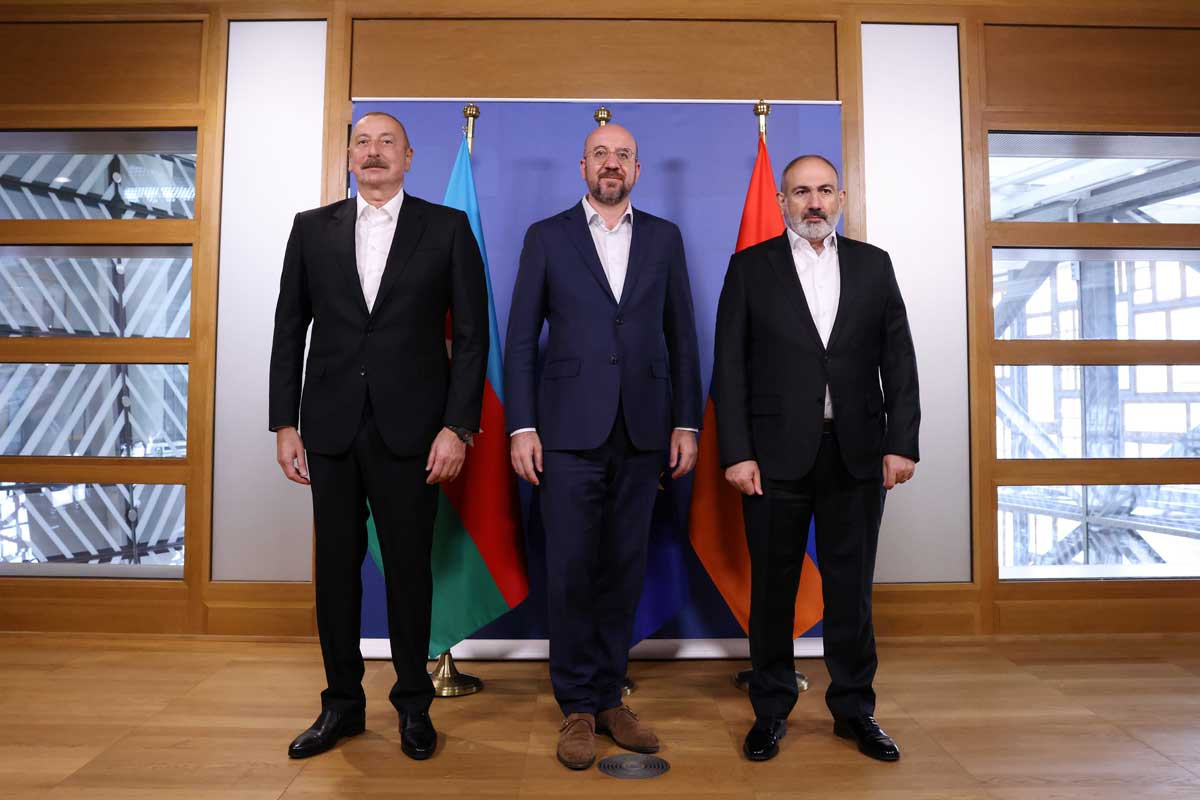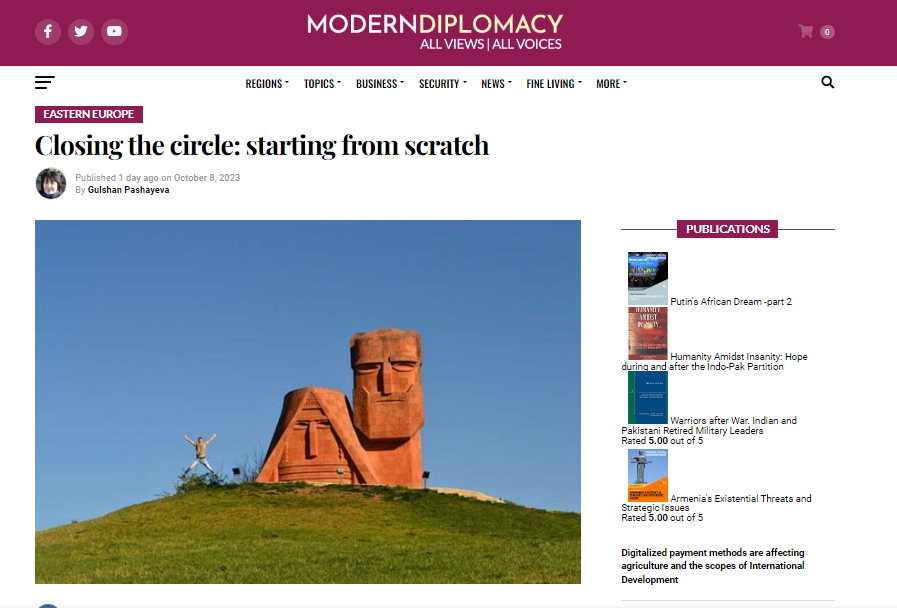On 21 December 2023, a historic football (soccer) match was played between two Azerbaijani football teams—FC Qarabag (Aghdam) and MOIK (Baku)—in Khankendi. FC Qarabag won one-nil.
This was the first sports event held in this city following the independence of Azerbaijan, and with the participation of Azerbaijani players and spectators. I had never been to Khankendi before, so it was also a great opportunity to visit this city and watch this important match as a spectator. At the same time, I decided to look retrospectively into this city's history and analyze the relationship between Armenians and Azerbaijanis from this angle.
According to most Azerbaijani sources, Khankendi (which means “village of the Khan,” derived from Xanın k?ndi in the Azerbaijani language) was once a small settlement built in the late XVIII century as a place where the ruler of the Karabakh Khanate, his immediate family and other relatives could live. The first ruler of the Khanate, Panah Ali Khan, initially built the fortress city, situated at an altitude of 1,300-1,600 meters above sea level, in 1752. It was named Panahabad Fortress after him. Later, the people started to call it Shusha Fortress, and, incidentally, Azerbaijan celebrated the two-hundred-and-seventieth anniversary of the establishment of Shusha in 2022. Many famous Azerbaijani writers, poets, thinkers, composers, and musicians from the city of Shusha have made invaluable contributions to the cultural legacy of Azerbaijan. Therefore, on 7 May 2021, to restore its historical appearance and former glory, Azerbaijani President Ilham Aliyev declared Shusha to be the cultural capital of Azerbaijan. Thus, both Shusha and Khankendi were from their foundation, closely associated with the rulers of the Karabakh Khanate.
It must be noted that the entire historic Karabakh region, including its lowland and mountainous parts, has a very long and dramatic history, and it cannot be disputed that a deep vein of history has run through this region over the centuries, as seen in various tangible objects and artifacts, Muslim and Christian historical and religious monuments associated with Caucasian Albanian, Azerbaijani, and Armenian cultural heritage.
Although Karabakh Armenians used to live predominantly in the mountainous part of the historic Karabakh region, Karabakh Azerbaijanis have never differentiated between its lowland and mountainous parts and perceive it “as a single geographical, economic and cultural space, where they have always been politically and demographically dominant.” Moreover, many Azerbaijanis considered the creation in 1923 of the Nagorno-Karabakh Autonomous Oblast (NKAO) within ‘artificial’ (i.e., previously nonexistent) borders an attempt to secure “an Armenian majority region within Azerbaijan as part of the Soviet/Russian policy of divide and rule.”[1]
With the establishment of the NKAO in 1923, Khankendi became the capital of this administrative-territorial unit and was renamed Stepanakert, after Armenian Bolshevik revolutionary Stepan Shahumian. However, the NKAO operated within Soviet Azerbaijan for only 68 years and ceased to exist by the “Law on Abolishment of Nagorno-Karabakh Autonomous Oblast” (resolution ? 279-XII), which was a motion passed by the Supreme Soviet of the Republic of Azerbaijan on 26 November 1991 and signed into law.[2] According to this law, Stepanakert along with two other cities within the former NKAO were renamed with their respective Azerbaijani names. Thus, Stepanakert was once again named Khankendi in law, but this did not happen in practice.
This was because of the illegal activities from 1988 of the irredentist Karabakh movement established in Armenia and the NKAO. This encouraged the mobilization of Armenian ethno-nationalists under the nationalist slogan miatsum or “unification” to demand the transfer of the NKAO from the jurisdiction of Soviet Azerbaijan to Soviet Armenia. In fact, the first demonstration that took place in Stepanakert on 13 February 1988, has traditionally been considered the start of this movement. Despite the rejection of this transfer by Soviet Azerbaijan, neither NKAO’s ethno-nationalists nor their supporters in Soviet Armenia and Armenian Diaspora relinquished their territorial claims. Moreover, with representation of Karabakh movement in the Supreme Soviet of the Armenian Soviet Socialist Republic (SSR) this body adopted a resolution “About reunion of the Armenian SSR and Nagorno-Karabakh” on 1 December 1989[3]. This was a serious violation of the constitutional norms of USSR, and was deemed by a resolution of the Presidium of the Supreme Soviet of Azerbaijan Soviet Socialist Republic (SSR) passed on 7 December 1989[4] as inadmissible interference in the affairs of the Azerbaijan SSR, and territorial encroachment. However, the involvement of Armenian SSR was continued further.
By 1989, the Karabakh movement had transformed into the Pan-Armenian National Movement and won the majority in the parliamentary election in May 1990. In fact, under the pressure of this movement Declaration of Independence of Armenia was adopted by the parliament on 23 August 1990[5]. This document[6] had a special clause related to the above-mentioned resolution on the reunion of Armenia and Nagorno-Karabakh, and, in turn, the Constitution of the Republic of Armenia[7] refers to the Declaration of Independence of Armenia until now.
Thus, the leaders of Armenia SSR as well as afterwards the independent Republic of Armenia encouraged the separatists in the former NKAO and played an instrumental role in further occupation of Azerbaijani territory in pursuit of irredentist claims and ethnic solidarity.
As a result of this policy, all Azerbaijani inhabitants of the historic Karabakh region were expelled and, for more than 30 years, the stadium in Khankendi, built in the mid-1950s during the Soviet era, was used by the Armenian inhabitants alone. Only following the Second Karabakh war as well as localized counter-terrorism measures carried out by Azerbaijani armed forces on September 19-20 2023, the illegal Armenian armed formations were disarmed and Armenia’s armed forces agreed to leave the territory of Azerbaijan. The head of the illegal separatist regime S. Shahramanyan also signed a decree on termination of so called “Nagorno-Karabakh Republic” on 28 September 2023. According to the said decree, all institutions of this illegal entity had to be dissolved before 1 January 2024.
Today Azerbaijanis are able to go to Khankendi. There is also a hope that, one day, some of the Karabakh Armenians, most of whom decided to leave Karabakh, will return to this place.
Everyone now hopes that the Armenian-Azerbaijani confrontation will finally sink into oblivion with a peace treaty to be signed soon and its successful implementation over the coming years.
However, today we are standing head-to-head with the unknown. Can the current Armenian government overcome the revanchist forces in the country and advance the peace agenda with Azerbaijan? Can both Armenians and Azerbaijanis despite current narratives and stereotypes, as well as the geopolitical implications be able to achieve a durable peace for future generations? Only one thing is clear today: that, in the short term, Azerbaijan and Armenia have to establish inter-state relations, which have been nonexistent since both countries regained independence in 1991. For this purpose, perhaps signing an “Agreement on Peace and Establishment of Inter-state Relations” is an important prerequisite.
[1]Tabib Huseynov. A Karabakh Azeri perspective. In: Accord. “The Limits of Leadership. Elites and societies in the Nagorny Karabakh peace process”. Conciliation Resources. Issue 17, 2005, p. 25 - https://rc-services-assets.s3.eu-west-1.amazonaws.com/s3fs-public/The_limits_of_leadership_Elites_and_societies_in_the_Nagorny_Karabakh_peace_process_Accord_Issue_17.pdf
[2] Az?rbaycan Respublikasının Dağlıq Qarabağ Muxtar Vilay?tinin l?ğv etm?k haqqında Az?rbaycan Respublikasının Qanunu - https://web.archive.org/web/20120326151255/http://karabakh-doc.azerall.info/ru/law/law012az.htm
[3]Joint resolution of Armenia SSR and Nagorny Karabakh Oblast on reunification, 1 December 1989 - https://www.legal-tools.org/doc/67c50c/pdf/
[4] Chronology of Armenian-Azerbaijan conflict (1987-1999) - https://karabakh.org/conflict/chronology-of-armenian-azerbaijan-conflict-1987-1999/
[5]Armenia Marks Anniversary of Declaration of Independence. Azatutyun.am, 23 August 2001 - https://www.azatutyun.am/a/1566943.html
[6]Declaration on the independence of Armenia of 23 August 1990 - https://cis-legislation.com/document.fwx?rgn=2902
[7] Constitution of the Republic of Armenia - https://www.constituteproject.org/constitution/Armenia_2015
http://turkishpolicy.com/blog/116/towards-a-durable-peace-an-important-prerequisite







